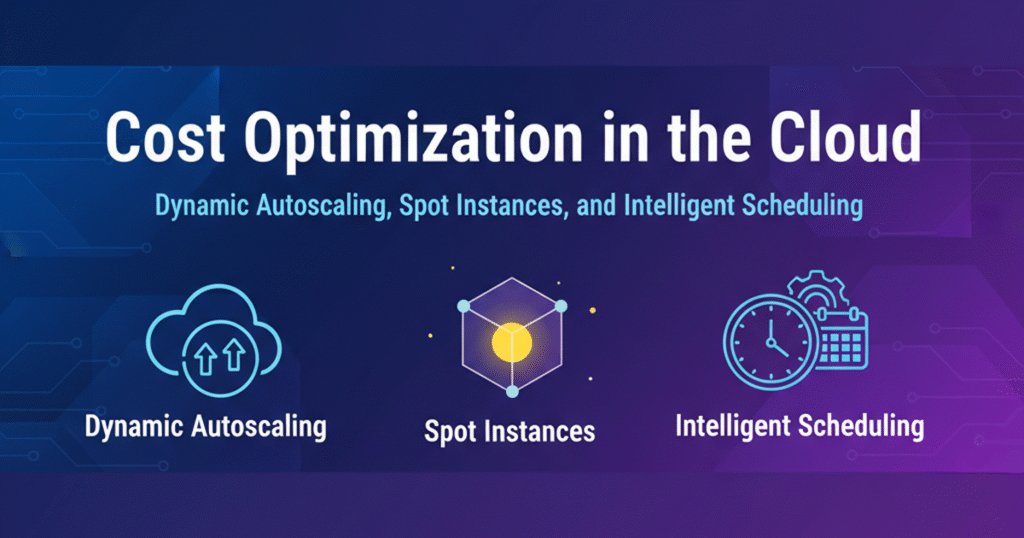Cloud bills rarely scream—you notice them after they’ve already crept up. The smarter alternative to “cutting spend” is cloud cost optimization: aligning consumption to real demand so you pay only for what you actually need. In this post I’ll walk through three high-impact levers—dynamic autoscaling, spot instances, and intelligent scheduling—and show how combining them gives you reliable performance and measurable cloud savings.

Why cloud cost optimization matters now
As applications grow, teams frequently over-provision out of caution: reserve for peak traffic, duplicate environments for dev/test, or keep heavy compute running overnight. That approach drives recurring waste. The aim of cloud cost management isn’t penny-pinching; it’s designing systems and processes that meet Service Level Objectives (SLOs) while minimizing idle spend.
The Three levers that deliver the biggest wins
1. Dynamic autoscaling
Autoscaling lets your infrastructure grow and shrink with demand. Basic threshold-based autoscalers work, but modern implementations combine horizontal autoscaling (add/remove instances) with vertical adjustments and cluster-level scaling. When tuned properly, dynamic autoscaling reduces idle minutes and ensures you’re not paying for headroom you don’t need.
Tip: use predictive autoscaling for workloads with predictable patterns (daily traffic cycles, batch windows). Forecasting reduces reaction lag and avoids unnecessary warm-up minutes.
2. Spot instances (preemptible VMs)
Spot or preemptible instances are spare cloud capacity offered at steep discounts. For workloads that tolerate interruptions—such as nightly ETL, CI jobs, or distributed ML training—spot instances can cut compute costs dramatically.
Best practices include checkpointing progress, breaking jobs into smaller tasks, and diversifying instance types or zones so a single market shock doesn’t interrupt everything.
3. Intelligent scheduling
Intelligent scheduling decides when and where work runs to balance cost and reliability. Cost-aware schedulers place non-urgent tasks on cheaper spot pools and reserve more stable capacity for latency-sensitive services. When combined with autoscaling, intelligent schedulers let you exploit the cheapest options without missing deadlines.
How these tactics work together
Think of dynamic autoscaling as controlling “how much” compute you need, spot instances as a discounted “what” to use, and intelligent scheduling as the “when” and “where”. Together they create a layered strategy:
Use savings plans or reservations for steady baseline consumption.
Autoscale the remainder dynamically to meet short-term demand.
Schedule variable or batch workloads on spot where feasible.
Apply cost-aware placement to reduce interruption risk while maximizing discounts.
Concrete, actionable tactics you can apply this week
1. Right-size continuously — analyze CPU/memory and resize instances that sit mostly idle. Small instance family switches compound into large monthly savings.
2. Pilot spot for non-critical workloads — start with nightly ETL or test suites; measure preemption impacts and success rates.
3. Implement checkpointing and retries — make batch and training jobs resilient to interruptions.
4. Adopt predictive autoscaling — for predictable traffic, add forecasting to reduce overprovisioning.
5. Use cost-aware schedulers or controllers — in Kubernetes, leverage spot-aware controllers or node pools; for batch systems, add cost-to-deadline logic.
6. Apply governance — tagging, automated shutdowns for dev/test environments, budgets and alerts keep surprises in check.
Operational playbook (practical rollout)
1. Discover: use cloud cost tools to identify the biggest spend drivers.
2. Pilot: move non-critical batch jobs to spot and measure.
3. Scale: add predictive autoscaling to services with repeatable load.
4. Automate: wire autoscale + schedule decisions into CI/CD and monitoring.
5. Govern: enforce policies, run monthly FinOps reviews, and iterate.
What kind of savings can you expect?
Results vary by workload, but conservative industry examples and studies show meaningful reductions: spot usage can lead to very large compute discounts for tolerant workloads, while good autoscale policies commonly cut waste from predictable diurnal patterns. The real win is combining techniques—committing to a baseline, offloading variable workloads to spot, and automating decisions—so savings scale predictably.
Closing: move from reactive to proactive cloud cost management
Cloud cost optimization is not a one-time project; it’s a continuous practice. Start small, measure, automate what works, and scale the approach. By combining dynamic autoscaling, spot instances, and intelligent scheduling, your team will not only reduce monthly bills but also build a more resilient, efficient platform that grows with your needs—not your invoices.
Search
Categories

Author
-
Salman is a DevOps Engineer with 8 years of IT experience, beginning his career in testing before moving into cloud engineering. Over the years, he has built expertise across AWS, Azure, and GCP, with a strong focus on containerization using Docker and Kubernetes. He is experienced in CI/CD automation with Jenkins, infrastructure as code with Terraform, and driving cloud cost optimization initiatives. Outside of work, he enjoys exploring emerging technologies, problem-solving with cloud-native solutions, and staying updated with the latest trends in DevOps.
